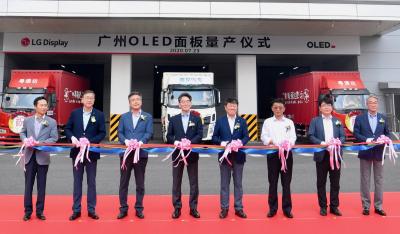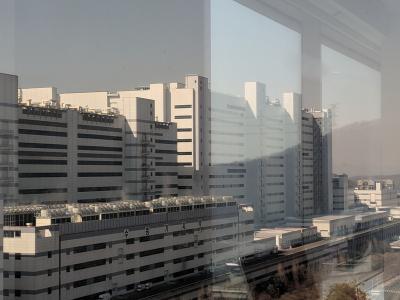OLED TV: Introduction and Industry News - Page 21
LG Display officially announces it has started to mass produce OLED TVs in Guangzhou
LG Display's original plan was to start producing OLED TV panels at its 8.5-Gen OLED fab in Guangzhou in October 2019, but following some technical issues, production was pushed back, several times.

Yesterday LGD announced that it has finally started mass production of its Guangzhou fab. The capacity of the Guangzhou fab is 60,000 substrates per month, which will almost double LGD's total OLED TV capacity to 130,000 substrates per month.LGD also plans to expand the Guangzhou fab to 90,000 monthly substrates in the future. The plant will be used to produce 48-inch, 55-inch, 65-inch, and 77-inch panels, and 48-inch OLED TVs will shortly start to ship.
UDC establishes a subsidiary to advance OVJP commercialization
Universal Display established a new subsidiary, called OVJP Corporation, that will advance the commercialization of UDC's OVJP OLED TV manufacturing technology.
OVJP stands for Organic Vapor Jet Printing, and the basic idea is to use a gas-stream based process that resembles ink-jet printing but one that uses evaporation OLED materials. In an OVJP process, the OLED materials are evaporated into a carrier gas that delivers them to a jet engine for direct printing of patterned OLED layers.
LG Display delays its P10 10.5-Gen OLED TV fab to 2025
In July 2019, LG Display announced an additional investment of $2.5 billion in its upcoming P10 10.5-Gen OLED TV fab in Paju. In June 2019 it was reported that LG display has started to install some of the Oxide-TFT deposition equipment. According to LG's original plans, mass production at the P10 fab was supposed to begin in 2021 or 2022, but this was later delayed to 2023.

It is now reported that LG Display has decided to delay the mass production at the P10 fab to 2025 or 2026 - this pretty much means the project is now on hold. LG Display is currently seeing lower demand for OLED TV panels, due to the Coronavirus pandemic.
LGD receives flicker-free eye-comfort certification for its OLED TVs from TUV Rheinland
LG Display announced that its OLED TV displays have been recognized for maximum eye comfort by leading global independent inspection service TÃV Rheinland of Germany and UL, a leading global safety science company.

LG Display's OLEDs were recognized as "Eye Comfort Displays" - with a low blue light emission and a flicker-free operation. This is the first time in the industry that TV displays have received such certifications.
DSSC updates its OLED industry outlook, sees an oversupply situation for smartphone OLEDs till 2025
DSCC updated its capacity and demand outlook for the OLED industry. DSCC says that the oversupply situation for smartphone OLEDs will continue to effect the industry for years ahead.

According to DSCC the reason for the oversupply is Samsung's near-monopoly on flexible OLED phone panels - and the fact that the company keeps prices high and prefers high profit margins even though it leads to low utilization rates. DSCC sees China's capacity (which includes LG's Gunagzhou fab) share to rise from 5% in 2017 to 30% in 2020 and finally to 49% in 2025.
TCL invests $187 million in JOLED, to jointly-develop OLED TV inkjet printing technologies
JOLED announced that TCL CSoT has invested 20 billion Yen (around $187 million USD) in the company, and has also signed an agreement to jointly develop OLED TV printing technologies.
This is a very interesting development. TCL has been a long time believer in inkjet printing for OLED displays, and the company has established Juhua Printing in 2016 (together with TianMa and other collaborators) as an "open-innovation platform" to develop ink-jet printing of OLED panels. JOLED was not involved as far as we know in this alliance - so has TCL given up on Juhua and is now aiming to rely on JOLED's technology?
LG starts shipping its 48" OLED TVs in Europe
LG Electronics finally started shipping the world's first 48-inch OLED TV. The OLED48CX is now shipping in Europe. The price is relatively high (1,999 GBP in the UK) but hopefully this will come down in price soon.

LG's CX OLED TVs, LG's entry-level OLEDs for 2020, feature LG's latest 3rd-Gen Alpha 9 processor, which offers better HDR tone mapping and deep learning algorithms to improve picture quality. The TVs also offer NVIDIA G-Sync compatibility for gamers. The TVs are available in 48-inch, 55-inch, 65-inch and 77-inch.
LGD's Guangzhou fab starts to produce 48-inch OLED TV panels
LG Display's original plan was to start producing OLED TV panels at its 8.5-Gen OLED fab in Guangzhou in October 2019, but following some technical issues, production was pushed back, several times. The latest report suggested that production will only begin in Q3 2020 - due to the Coronavirus pandemic, and lower market demand.

Business Korea reports today that LGD finally started to produce panels in the Guangzhou fab - 48" OLED TV panels. It seems as if LGD has not achieved mass production yet, but some panels are already being produced. Mass production will begin, according to BK, later this month.
B&O adds a 88-inch 8K model to its Beovision Harmony OLED TV range
Bang and Olufsen announced a new flagship TV, at the top of its Beovision Harmony OLED TV range - a 88" 8K model, based on LGD's WOLED panels. The TV features a frame that includes a pop-up dual wood speaker mechanism that opens up when the TV is in use.

The 88" BeoVision Harmony costs $49,000. It joins the 2019 65" 4K model ($15,700) and 77" 4K model ($19,800).
LGD pushes back production at its Guangzhou OLED TV fab to Q3 2020
LG Display's original plan was to start producing OLED TV panels at its 8.5-Gen OLED fab in Guangzhou in October 2019, but the company faced technical issues, pushed back production to the end of January 2020 - but fixing these issues took longer than expected.

The CoronaVirus outbreak caused LGD further delays, and mass production was again delayed to 'early' Q2 2020. The latest news from Korea suggests that now LGD has pushed back production in the Guangzhou fab to Q3 2020. The cause of these delays, is again yield issues, slow engineering work due to the Coronavirus isolation - and lower demand in the market (which seems to suggest that LGD is not in a rush to begin production).
Pagination
- Previous page
- Page 21
- Next page

